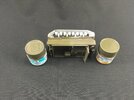Plastic Pilot
Member
- Joined
- May 25, 2024
- Messages
- 75
Hello kind sires,
I'm having a problem with measuring the paint quantity, because I don't have a particular shade of green that I need for a model, so I have to mix up paints to get what I need. The problem is that even if I use the eyedropper, I have to use a big amount of paint each time for the mixing and after painting I have to trow away what is left because the first layer dose not dry in time in comparative with amount of time that the paint stays wet on the pallet, even if I use a wet pallet the paint just dries out.
So to get the same shade again, I have to mix the paints at the same amount as for the first time, and to get the same shade right you have to waste the paint, I thought to use paint retarder so it can stay wet for some more time, and the in the first half our I usually wait for the first layer to dry, the paint may still be wet.
Please, if you wish, can you tell me how do you manage to get the shade you want exactly the same every time you need it, of course if you don't mind trowing away the surplus paint.
Thank you for your answer.
I'm having a problem with measuring the paint quantity, because I don't have a particular shade of green that I need for a model, so I have to mix up paints to get what I need. The problem is that even if I use the eyedropper, I have to use a big amount of paint each time for the mixing and after painting I have to trow away what is left because the first layer dose not dry in time in comparative with amount of time that the paint stays wet on the pallet, even if I use a wet pallet the paint just dries out.
So to get the same shade again, I have to mix the paints at the same amount as for the first time, and to get the same shade right you have to waste the paint, I thought to use paint retarder so it can stay wet for some more time, and the in the first half our I usually wait for the first layer to dry, the paint may still be wet.
Please, if you wish, can you tell me how do you manage to get the shade you want exactly the same every time you need it, of course if you don't mind trowing away the surplus paint.
Thank you for your answer.

